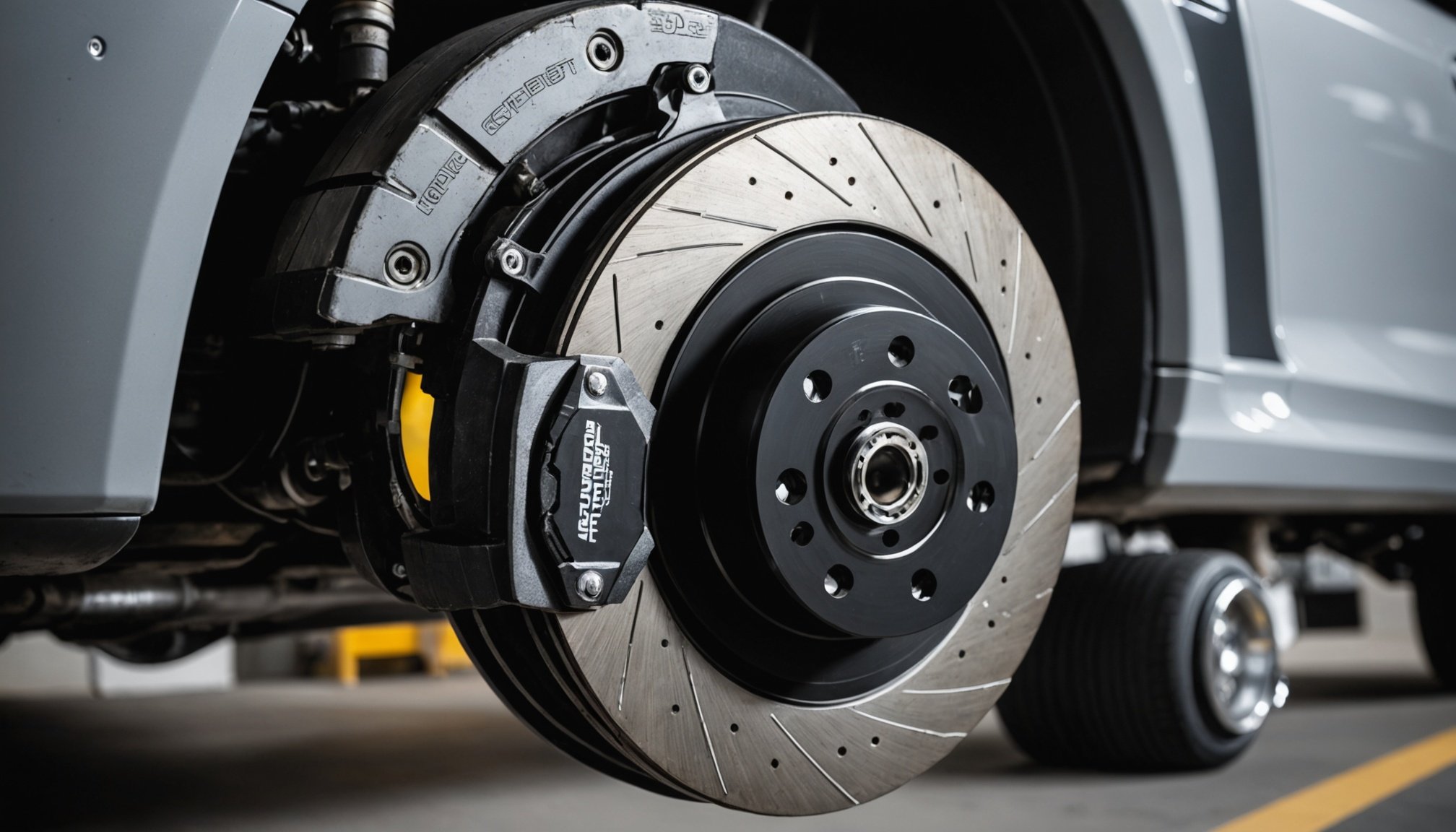Understanding Enhanced Ceramic Brake Pads
Enhanced ceramic brake pads offer a modern alternative in vehicle braking systems, renowned for their superior stopping power and minimal noise production. These brake pads are made from ceramic fibres, non-ferrous filler materials, and bonding agents, providing distinct advantages over traditional metallic and organic brake pads.
A significant benefit of ceramic brake pads is their improved braking performance. When compared to metallic brake pads, ceramic pads produce less dust and withstand higher temperatures, making them a preferred choice for those seeking reliable and consistent braking in various conditions. They offer a quieter performance with less wear on the rotors, contributing to a smoother driving experience.
Topic to read : Ultimate guide to tire rotation for 4wd vehicles: promote balanced wear and boost safety
Enhanced ceramic brake pads surpass organic variants in durability and fade resistance, ensuring dependable stopping power without compromising on comfort or noise levels. This is particularly advantageous for owners looking for a maintenance-friendly, enduring solution that mitigates daily wear and tear.
In evaluating braking performance metrics, it’s crucial to consider how brake pad choice affects stopping distance, noise production, and heat resistance. Assessing these factors with precision can significantly enhance vehicle safety and performance, making enhanced ceramic brake pads a sound investment for both everyday and high-performance applications.
Topic to read : Ultimate handbook: safely upgrading your rearview mirror in vehicles with advanced driver assistance systems (adas)
Benefits of Using Enhanced Ceramic Brake Pads
Exploring the advantages of ceramic brake pads reveals notable features such as their superior heat dissipation which plays a crucial role in overall brake performance. By effectively managing heat, these pads avert overheating—a common issue in brake systems. This leads to a more stable and consistent braking response, essential for maintaining safety in high-pressure situations.
Another remarkable feature of ceramic brake pads is their reduced noise levels. Traditional materials often produce unsettling sounds, especially after prolonged use. Ceramic pads, however, minimise this by dampening vibrations—a relief for those who value a quiet ride. This enhancement not only benefits the driver’s comfort but also extends the life of other braking components.
When it comes to longevity, the wear rates of ceramic brake pads stand out. Compared to organic or metallic alternatives, they exhibit slower deterioration, thus offering a cost-effective solution in the long run. Their resilience against daily wear and tear makes them a preferred choice for individuals seeking durability without compromising on the effectiveness of their braking system.
Overall, the heat resistance and noise reduction features inherent in ceramic brake pads provide an edge in performance and dependability, making them a worthy consideration for any vehicle owner.
Installation Guide for Ceramic Brake Pads
The proper installation of ceramic brake pads involves a methodical approach whether opting for DIY installation or seeking a professional service. Ensuring your vehicle’s braking system operates at peak efficiency hinges on this critical process.
Step-by-Step DIY Installation Process:
-
Tools and Materials: Essential items include a jack, lug wrench, C-clamp, Allen wrenches, and new ceramic brake pads. Having these ready ensures a smoother process.
-
Preparation: Secure the vehicle on a flat surface, using the jack to lift and support it. Remove the wheel using the lug wrench to expose the brake caliper and pads.
-
Pad Replacement: Detach the caliper with Allen wrenches and gently remove the existing brake pads. Use a C-clamp to retract the caliper piston, making room for the new pads. Insert the ceramic pads into the caliper bracket.
-
Reassembly: Reattach the caliper and ensure all components are securely fastened. Mount the wheel back using the lug wrench.
Professional vs. DIY Installation:
While many enthusiasts find DIY fulfilling, consulting professional services can provide reassurance, especially for those unfamiliar with technical aspects. Expertise guarantees proper handling of intricate elements, especially for high-performance vehicles where precision is paramount. Consider your skill level and tools availability when deciding the best approach.
Performance Reviews of Enhanced Ceramic Brake Pads
When it comes to brake pad reviews, enhanced ceramic brake pads often solidify their standing through positive performance testing results. Independent evaluations highlight their excellent braking performance, superior stopping power, and noise reduction capabilities. Users generally report noticeable improvements in vehicle handling and safety, underscoring their reliability in everyday and high-stress conditions.
User feedback plays a significant role in understanding the real-world implications of using ceramic brake pads. Many vehicle owners appreciate the minimal dust production and durability, often attributing these features to the ceramic composition’s resilience. The feedback is overwhelmingly positive, with recommendations commonly suggesting these pads for those prioritising longevity and a quieter braking experience.
In terms of expert recommendations, organisations frequently rank certain models of ceramic pads at the top for their performance features. These features include advanced wear resistance and consistent performance under various temperatures. Professionals advise that when selecting ceramic pads, one should consider the specific driving conditions and the vehicle’s make and model to optimise compatibility.
Overall, the fusion of user experiences with expert insights provides a comprehensive overview of the benefits that enhanced ceramic brake pads can offer, solidifying their status as a preferred choice in the market.
Maintenance Tips for Enhanced Ceramic Brake Pads
To maximise the lifespan and braking performance of enhanced ceramic brake pads, proper maintenance is crucial. Regular brake pad maintenance not only sustains performance but also ensures vehicle safety. Here’s how to keep them running smoothly:
Routine checks are essential. Inspect the brake pads for signs of unusual wear or damage, such as cracking or uneven thickness, which can affect stopping power. Regularly monitor brake fluid levels, as low fluid can lead to suboptimal performance.
Here are some signs to watch for:
- Squeaking or grinding noises: Indicate pads may be overly worn. If you hear these sounds, an immediate inspection is required.
- Vibrating brake pedal: May imply warped rotors or pad issues necessitating urgent attention to prevent further damage.
- Increased stopping distances: A clear indication of compromised brake effectiveness, often due to worn pads.
Prioritising routine maintenance aids in extending brake life and detecting potential problems early. Regular professional inspections can further enhance the longevity of your brakes. Always address any issues promptly to avoid further complications. By following these upkeep tips, you will enjoy the full benefits of your ceramic brake pads, ensuring safety and reliability in everyday driving conditions. Regular maintenance, therefore, is not just recommended; it’s essential for proper vehicle function.
Safety Insights Related to Brake Pads
Enhanced ceramic brake pads play a vital role in ensuring vehicle safety by providing consistent and reliable braking performance. Their construction enhances braking effectiveness, significantly reducing the risk of brake failure. By delivering superior heat resistance and noise reduction, these pads maintain optimal braking conditions even during demanding driving scenarios.
Brake fade, a concern in high-stress braking situations, occurs when the braking system becomes less effective due to overheating. Enhanced ceramic brake pads are designed to combat this, thanks to their excellent heat dissipation properties, thereby ensuring sustained stopping power. Preventing brake fade is crucial for maintaining control and safety, especially in situations requiring sudden stops.
Matching brake pads to your specific driving conditions and vehicle type is essential. For instance, frequent city drivers might favour ceramic pads for their capability to handle stop-and-go traffic with minimal noise. Meanwhile, those driving in rugged terrains may need pads that can withstand higher stresses, ensuring consistent braking performance.
Safety tips include routine checks for pad wear and maintaining proper brake fluid levels. Selecting the appropriate pad type not only enhances safety but also aligns with your vehicle’s performance needs, ultimately offering peace of mind on the road.
Expert Recommendations for Choosing Brake Pads
Selecting the appropriate brake pads can profoundly impact your vehicle’s performance and safety. According to automotive experts, considering your driving habits and conditions is crucial. For instance, if you frequently navigate urban environments, enhanced ceramic brake pads are ideal due to their noise reduction and superior heat resistance. However, for those who engage in spirited driving or traverse rugged terrains, options focusing on stopping power and durability might be more suitable.
When making your decision, it’s essential to evaluate performance testing results. These reviews often indicate the pads’ efficacy in terms of braking performance and longevity. Understanding these metrics ensures you choose a product compatible with your vehicle’s demands.
Consulting experts can also guide you toward manufacturers offering reliable warranties and guarantees. Such assurances indicate the brand’s confidence in their product’s performance and durability, ensuring peace of mind over long-term use. Remember, expert advice caters to both everyday use and more specialised, high-performance needs.
Finally, your choice should reflect a balance between cost and quality. While some premium pads may boast advanced features, their higher price may not always align with your requirements. Therefore, informed selection based on expert guidelines optimises both safety and reliability.











